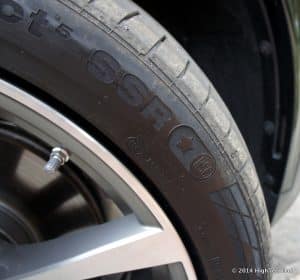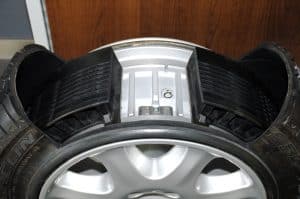Run-Flat Tires – Pros, Cons and Information


run-flat tires
Flat tires can be bothersome.
You are in a hurry to get to a business meeting and suddenly one of your tires has a puncture. To make matters worse, your spare tire is deflated. If you want to avoid this, you need to invest in a set of run-flat tires.
The other option is self-sealing tires. These have a sealant inside the tire that seals holes caused by nails. The sealant is activated when you remove the nail from the car. With a self-sealing tire, you can continue driving with little pressure loss even after a puncture.
Contents show
What are run-flat tires?
They are sometimes also called zero-pressure tires. Most car models now have the option of using tires with run-flat properties. Instead of carrying a spare tire, you only need a repair kit. Run-flat tires help you drive the car the next 100 miles.
If you have a modern car, you will notice that the pressure monitoring unit has turned red, which means you are driving at low pressure. The sidewalls of run-flat tires are stiff, so they can still carry the weight of the car. Many car manufacturers have eliminated the replacement tire because of the extra weight it puts on the car. If you factor in the need for a wrench and jack, the car is much lighter without them.
Tires with run-flat properties use two load-bearing systems – self-supporting and ring-shaped. In the event of a loss of pressure, you have a self-supporting, reinforced sidewall that keeps the car moving even after a puncture. The ring is a load-bearing structure inside the tire that keeps it stable. The distance you can travel with the tires is determined by the manufacturers.
Pros
Car stability: Whenever a sudden tire blows out, the car loses control and you could hit incoming cars. This is the main cause of fatal car accidents when a tire has burst. With a run-flat tire, the car retains its stability even after a tire blowout. This is because the tire can carry the entire weight of the car for miles. As a driver, you will experience greater stability and control of the car even after a flat tire.
Drive for miles with flat tires: The main reason for installing run-flat tires is the ability to go up to 100 miles on a flat tire. In this case, you don’t have to let a flat tire disrupt your schedule. This is convenient when you are driving on a dangerous road or when it is raining.
Lighter cars: A lighter car is an advantage due to better fuel efficiency. The spare wheel and jacks put extra weight on your car. In addition, run-flat tires have been found to weigh less than conventional tires.
Trunk space: If you have a car from a manufacturer that is equipped with run-flat tires, you will enjoy extra space in the boot. This is because space has been converted from spare tire and jack usage into something more convenient.
Cons

Blowouts still happen: The tires wear out over time, and a run-flat tire is no exception. A flat tire can occur when you drive a run-flat tire that is not properly inflated. If the puncture is on the sidewall, the tire can burst and cause some driving instability. This means that you will have to buy a new set of tires.
Lack of spare tire: The reason why manufacturers offer run-flat tires is that they don’t need a spare wheel. However, imagine you have a full puncture and you have no spare wheel. You also do not have the tools to change the tire. This includes the wrench and the jack. If you have a full puncture and the flat tire becomes unusable, you will be forced to have the car towed.
Frequent replacement: The run-flat tire has a softer thread mixture to counteract the hard thread. This puts extra pressure on the tire and it wears out faster than conventional tires. On average, car owners with run-flat tires replace them more often than those with conventional tires.
Harsher ride: The stiff sidewalls make for a harder ride compared to conventional tires. If you bought the car with the tires, the manufacturer will have adjusted the suspension to compensate for this stiffness. However, if you want to fit run-flat tires to your car, you will need to take the car to a mechanic who will adjust the suspension for you.
Less variety: Run-flat tires are new, which means you can’t choose from a variety of tires. They are expensive and you must take this into account when you have a complete set of tires. But manufacturers are increasingly developing run-flat tires, which means that in a few years consumers will have more options to choose from.
Conclusion
Run-flat tires have gained popularity in recent years. What makes them stand out is their reinforced sidewall. One of the biggest advantages of owning run-flat tires is that you can continue driving even after a puncture; for most tires up to 100 miles.
If you buy a car with run-flat tires, you have no spare tire and no jack. This makes the car lighter and you have more space. However, run-flat tires are more expensive than regular tires, and there is still a chance that you will have a flat tire – especially if the tires are worn out. Run-flat tires are new on the market, so you don’t have much choice.
However, as their popularity increases, they are being adopted by more and more car manufacturers. The reinforced sidewall makes the tire hard and you will experience a harder ride than with normal tires. However, this shortcoming can easily be overcome by adjusting the suspension. Tires with run-flat characteristics allow you to dispense with the pressure caused by a lack of vehicle stability in the event of a puncture. The driver retains the steering and thus prevents accidents.
shares
Run-Flat Tires – Pros, Cons and Information was last modified: May 19th, 2020 by Magnus Sellén
